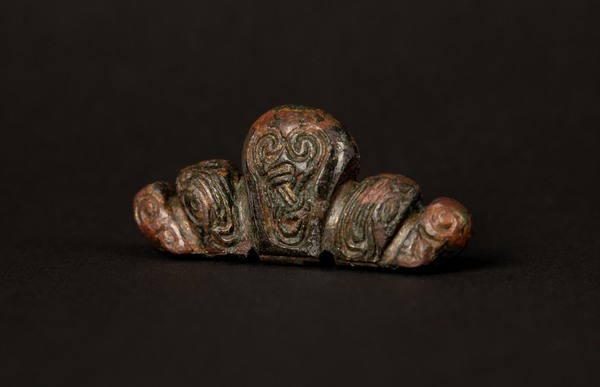Tenth-Century Viking Sword Fragment discovered in The Netherlands

A fragment of a tenth-century Viking sword was discovered near the Frisian town of Witmarsum.
This is a pommel cap, which once crowned the hilt of a sword and may have been gilded. This special fragment, the first of its kind found in the Netherlands, offers a rare insight into the intercultural networks of the Viking world and the crucial role Frisia played in them. The Fryske Akademy and the Fries Museum are jointly conducting additional research into the find, which has been added to the museum’s collection.
Archaeology enthusiast Sander Visser from Lelystad made this discovery on 3 May 2024 on farm near Witmarsum. When his detector emitted a high, clear sound, he started digging and came across this object buried less than 20 centimetres deep. Visser immediately realised that it was part of a pommel and that it stood out because of its decoration.
The discovery, decorated in the characteristic tenth-century ‘Mammen style’, is a fascinating example of Viking craftsmanship. Both ends have animal heads copying those of a wild boar; the boars’ upward curling mouths are still clearly visible. In Viking culture, wild boars symbolised strength and courage, and were associated with combat and protection.
The discovery of this Viking artefact in Friesland underlines the role the area played as a link in the Viking networks. Dr Nelleke IJssennagger-van der Pluijm, director of the Fryske Akademy and an expert on Frisia and the Viking world, says: “This extraordinary find shows that there is still a lot to discover about the Viking Age in Frisia, an area larger than presentday Friesland, about which we have learned a lot through research in recent years. Because this beautiful pommel cap is the first of its kind to be found in the Netherlands, it enriches our understanding of the contacts between Frisia and the Viking world in Scandinavia and the British Isles, and adds a new dimension to our historical knowledge.”
With support from the Netherlands Organisation for Scientific Research (NWO), Dr Diana Spiekhout, curator of Middle Ages and Mound Culture at the Fries Museum, has long been researching swords from early medieval Frisia that once included the Dutch coastal region, the area around Utrecht and the German East Frisian coast.
Swords were much more than just weapons during the early medieval period in northern and north-western Europe. People attributed human characteristics to them and they could have important symbolic value. “You could call these ‘epic’ swords,” says Diana Spiekhout. Swords with a formidable reputation were passed down for generations within elite networks, with successive owners sometimes adding ornate decorations or replacing parts. Evidence of this way of treating swords has been found in Frisia, but mainly up to the eighth century. Any decorations added later than this were usually standardised.
This recently found fragment raises all sorts of questions about the ‘life’ of the sword it once belonged to. Was this pommel cap, a luxurious addition, perhaps deliberately removed by a new owner who wanted to customise the sword to his own liking? Or was the entire sword actually disassembled? And how did it end up in Friesland?
Main Image: Pommelkap, Witmarsum, 900-1000 - Fries Museum, image by Allison James
